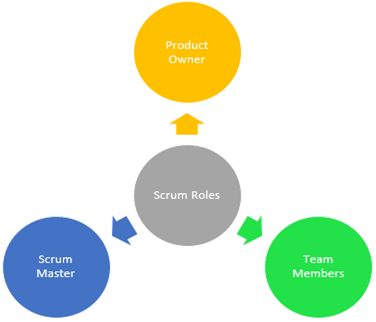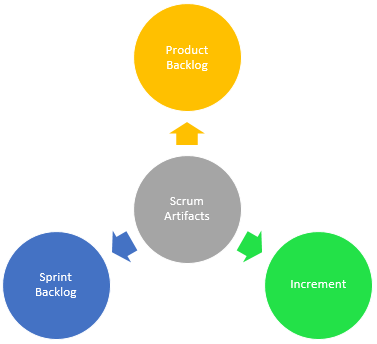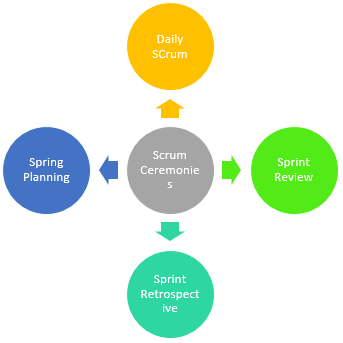In Agile project methodologies, the scrum has a short schedule of the release cycles that is fixed and has the adjustable scope known as sprints. Sprints help to track the progress of the stories backlog to build the complete software and address the development need in order to cater to the frequent changes. The scrum is different from other agile concepts and practices. It can be categorized into roles, artifacts, and ceremonies. It has three specific roles which are the product owner, scrum master, and scrum team members. It maintains three artifacts which are the increment, product backlog, and sprint backlog. The scrum methodology has four ceremonies. They are the Daily Scrum, sprint planning meeting, sprint review meeting, and sprint retrospective meeting.
In the Scrum project methodology, there are a number of recurring sequence of meetings, to be held before, within, and after the sprint cycle.
Roles in Agile Scrum
In the Agile Scrum framework, it has the following three project roles.
- Product Owner: The product owner helps to create the user stories and groom these stories with the help of the team member.
- Scum Master: Scrum master is the team member who serves as the servant leader and runs a daily scrum meeting to track the progress of the stories in the sprint.
- Team members: The team members are the actual assignees of the user stories who perform the tasks of designers, analysts, architects, developers, and testers. The scrum has given the least importance to the project roles instead it is focused on the quickest possible delivery of the high-quality software product or application.

Artifacts in Agile Scrum
In the Agile Scrum framework, it has the following three artifacts.
- The product increment: It is the order in which sprints are assigned to the product backlog to complete the software deliveries.
- The product backlog: All stories added to the Scrum appeared as the product backlog. In other words, the product backlog shows the tasks and issues which are yet to be implemented by the scrum team members.
- The sprint backlog: The product backlog is refined based on the user stories priorities and the team member bandwidth into a fixed and short schedule of the release cycle know is the spring. All stories that are added to the current sprint are known as the sprint backlog.

Ceremonies are also known as Meetings in the Agile Scrum framework. Ceremonies are an important part of agile development as they help to broadcast timely information, provide a common goal and vision to the team, and tracks the team progress. All ceremonies are mandatory to be attended by the complete Scrum team except the retrospective where the product owner is optional. The following are the different ceremonies in the Agile Scrum.
Ceremonies in Agile Scrum
In the Agile Scrum framework, it has the following four ceremonies.
The sprint planning meeting:
The Sprint Planning answers the following questions.
- What are we going to work on in the upcoming Sprint?
- How are we going to work to deliver it?
It is required from the team members to have a shared goal and commitment before the beginning of the current Sprint composed of the list of deliverable items that the team plans to work on during that specific Sprint. The team can further break down these items into tasks, typically no bigger than 2 days’ worth of work or the story points.
Daily Scrum stand-up meeting:
A daily Scrum stand-up meeting has set up after completion of the planning of the backlog items in the sprint. The scrum meeting is hosted by the Scrum Master which is usually a 15-minute stand-up meeting. It helps to coordinate the work among the team members and establishes the team work visibility in the Sprint. The daily stand-up scrum meeting has the following three agendas for every team member.
- what’s done on the prior day?
- What are the impediments?
- what needs to be done today?
The sprint review meeting:
The sprint review meeting has held at the end of each sprint to determine the added functionality. It is set up mainly to get feedback from the product owner and other project stakeholders. It helps to ensure that the delivered increment is meeting the required business expectation or some revision is required with the Product Backlog based on the feedback. The feedback helps to improve team productivity towards the Product Backlog in a future Sprint.
The sprint retrospective meeting:
The sprint Retrospectives meeting can typically last for 90 minutes where the key focus is to help the team to incorporate continuous improvement into the team culture and Sprint rhythm. The Scrum Team gathers to reflect on their previous Sprint and figure out dos and don’ts in order to improve as a team by asking the following questions.
- what went well?
- what did not go well?
- what can be improved?
It helps the team to focus on their overall performance and identify the scope for continuous improvement.

Sprint Backlog Refinement
The product Backlog refinement is the process through which the team can add details, estimate, and order to items in the Product Backlog. Here, the Product Owner and the Development Team co-operate together on the details of Product Backlog items. The deliverable items are reviewed and revised. It is an ongoing activity, and it is not restricted to be a time-boxed event unless the goal has achieved. However, the use of time-boxing is a good practice.
Conclusion
Scrum ceremonies are a very important part of the Agile Scrum framework. They help to create a rhythm in the team to maximize their productivity, increases the team collaboration, maintain transparency, and injects the scope to inspect and adapt to the way they go. They provide the platform to the team members to learn continuously and improve from each other.
- What Is The Difference Between Scrum, Kanban And XP?
- Why QA Managers Are Not Needed in Agile Projects?
- Test Automation During Sprint
- There is NO QA Team in Agile
- 70+ Comprehensive Agile Project Management Tools List
- How Tester Add Values In Agile Project?
- Agile Testing Mindset And The Role Of The Agile Tester!!
- Documentation in Agile: How Much and When to Write It?
- Why Should Enterprises Embrace DevOps and Agile in Today’s Age of Digital Disruption?
- Difference Between Iterative and Incremental Development in Agile
